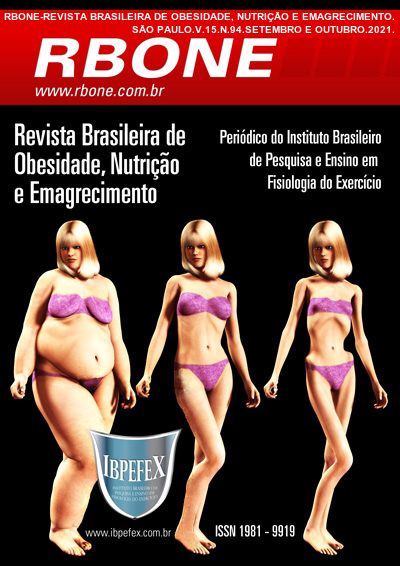The correlation between body fat percentage measured by bio-impedance and corporal circumferences in morbid obese
Abstract
Objective: To relate the results of the percentage of fat analyzed by the method of electrical bioimpedance (BIA) in morbidly obese women with the results obtained from fórmulas that use body circumferences as a reference. Materials and Methods: Twenty-three women (n=23) participated in the study. Two meetings were scheduled for the evaluations, the first of which was the measurement of height and bioimpedance assessment and the second for the measurements of waist, hip, abdominal and neck circumferences. Results: Significant differences were found (p<0.05) in the comparison between the percentage of fat obtained with BIA and the fórmulas of Lean, Weltman and Deurenberg. However, no significant differences were found (p>0.05) when comparing the percentage of fat between BIA and Tran and Weltman fórmulas (p>0.05). Although the correlation between BIA and the fórmulas of Lean (R=-0.26) and Tran and Weltman (R=0.26) is not significant (p>0.05), the present study demonstrated a significant correlation (p<0.05) with the formulas of Weltman (R=0.54) and Deurenberg (R=0.56). Conclusions: There is a significant correlation between the values of the fat percentage of morbidly obese individuals obtained by BIA with traditional methods that involve measures of body circumference.
References
-Balsalobre-Fernández, C., Glaister, M., & Lockey, R.A. The validity and reliability of an iPhone app for measuring vertical jump performance. Journal of Sports Sciences. Vol.33. Num.15. 2015. p.1574-1579.
-Caballero, B. The global epidemic of obesity: an overview. Epidemiol Rev. Vol.29. 2007. p.1-5.
-Cômodo, A.R.O.; Dias, A.C.F.; Tomaz, B.A.; Silva Filho, A.A.; Werustskym, C.A.; Ribas, D.F.; Spolidoro, J.; Marchini, J.S. Utilização da bioimpedância para avaliação da massa corpórea. Associação Médica Brasileira e Conselho Federal de Medicina. 2009. p.1-13.
-Demura, S.; Sato, S.; Kitabayashi, T. Percentage of total body fat as estimated by three automatic bioelectrical impedance analyzers. Journal of Physiological Anthropology and Applied Human Science. Vol.23. Num.3. 2004. p.93-99.
-Deurenberg, P.; Deurenberg-Yap, M.; Wang, J.; Lin, F.P.; Schmidt, G. Prediction of percentage body fat from anthropometry and bioelectrical impedance in Singaporean and Beijing. Asia Pacific. J. Clin. Nutr. Vol.9. Num.2. 2000. p.93-98.
-Deurenberg, P.; Weststrate, J.A.; Seidell, J. Body mass index as a measure of body fatness, age- and sex-specific prediction fórmulas. Br. J. Nutr. Vol.65. Num.2. 1991. p.105-114.
-Faria, A.C.; Navarro, F. Avaliação do percentual de gordura corporal de pacientes obesos que foram submetidos à cirurgia bariátrica pela técnica de Fobi Capella. Revista Brasileira de Obesidade, Nutrição e Emagrecimento. São Paulo. Vol.1. Num.6. 2007. p.60-73.
-Haslam, D. Obesity: a medical history. Obes Rev. Vol.8. Suppl.1. 2007. p.31-36.
-Herdy, C.V.; Figueiredo, T. ; Costa e Silva, G.; Galvao, P.V.; Vale, R.G.S.; Simao, R. Comparison between anthropometry and multi-frequency bioimpedance for body composition evaluation in Brazilian elite U-20 soccer athletes. Motricidade. Vol.16. 2020. p. 4-11.
-Habácek, J.H.; Pikhart, H.; Peasey, A.; Kubínnová, R.; Bobák, M. FTO variant, energy intake, physical activity and basal metabolic rate in Caucasians. The HAPIEE study. Physiological Research. Vol.60. 2011. p.175-183.
-Lean, M.E.J.; Han, T.S.; Deurenberg, P. Predicting body composition by densitometry from simple anthropometric measurements. Am J Clin Nutr. Vol.63. 1996. p.4-14.
-Lobo, H.A.; Baxter, Y.C.; Kiss, M.A.P.D.M.; Carazzato, J.G.; Gagliardi, J.F.L.; Perrout, J.L. Estudo comparative de avaliação da composição corporal pelos métodos antropométrico, bioimpedanciometria e hidrodensitometria em atletas masculios competitivos de judo. Rev Bras Med Esport. Vol.2. Num.1. 1996. p.3-6.
-Lohman, T.G.; Roche, A.F.; Martorell, R. Anthropometric standardization reference manual. Human Kinetics Books. Lllinois. 1988.
-Norton, K. Estimativas Antropométricas de Gordura Corporal. In: Norton, K.; Olds, T. Antropométrica: um livro sobre medidas corporais para o esporte e cursos da área da saúde. Porto Alegre. Artmed. 2005.
-Pimenta, G.P.; Saruwatari, R.T.; Corrêa, M.R.A.; Genaro, P.L.; Aguilar-Nascimento, J.E. "Mortality, weight loss and quality of life of patients with morbid obesity: evaluation of the surgical and medical treatment after 2 years." Arquivos de Gastroenterologia. Vol.47. 2010. p.263-269.
-Rodrigues, A.E.; Marostegan, P.F.; Mancini, M.C.; Dalcanale, L.; Melo, M.E.; Cercato, C.; Halpern, A. Análise da taxa metabólica de repouso avaliada por calorimetria indireta em mulheres obesas com baixa e alta ingestão calórica. Arquivos Brasileiros de Endocrinologia & Metabologia. Vol.52. 2008. p.76-84.
-Rodrigues, M.N.; Silva, S.C.; Monteiro, W.D.; Farinatti, P.T.V. Estimativa da gordura corporal através de equipamentos de bioimpedância, dobras cutâneas e pesagem hidrostática. Rev Bras Med Esporte. Vol.7. Num.4. 2001. p.125-131.
-Weltman, A.; Seip, R.L.; Tran, Z.V. PractiCal assessment ofbody com- position in obese males. Hum Biol. Vol.59. 1987. p.523-536.
-Weltman, A.; Levine, S.; Seip, R.L.; Tran, Z.V. Accurate assessment of body composition in obese females. Am J Clin Nutr. Vol.48. Num.5.1988. p.1179-1183.
-World Health Organization (WHO). Report of a WHO consultation on obesity. In: Obesity - preventing and managing the global epidemic. Núm. 265. 2000.
-Tran, Z.V.; Weltman, A. Generalized equation for predicting body density of women from girth measurements. Med Scien Sports Exerc. Vol.21. Num.1. 1989. p.101-104.
Copyright (c) 2022 Renato Vidal Linhares, Felipe Monnerat Marino Rosa, Gabriel Costa e Silva, José Carlos do Vale Quaresma, João Regis Ivar Carneiro, José Fernandes Filho

This work is licensed under a Creative Commons Attribution-NonCommercial 4.0 International License.
Authors who publish in this journal agree to the following terms:
- Authors retain the copyright and grant the journal the right of first publication, with work simultaneously licensed under the Creative Commons Attribution License BY-NC which allows the sharing of the work with acknowledgment of the authorship of the work and initial publication in this journal.
- Authors are authorized to enter into additional contracts separately for non-exclusive distribution of the version of the work published in this journal (eg, publishing in institutional repository or book chapter), with acknowledgment of authorship and initial publication in this journal.
- Authors are allowed and encouraged to post and distribute their work online (eg, in institutional repositories or on their personal page) at any point before or during the editorial process, as this can bring about productive change as well as increase impact and impact. citation of published work (See The Effect of Free Access).






